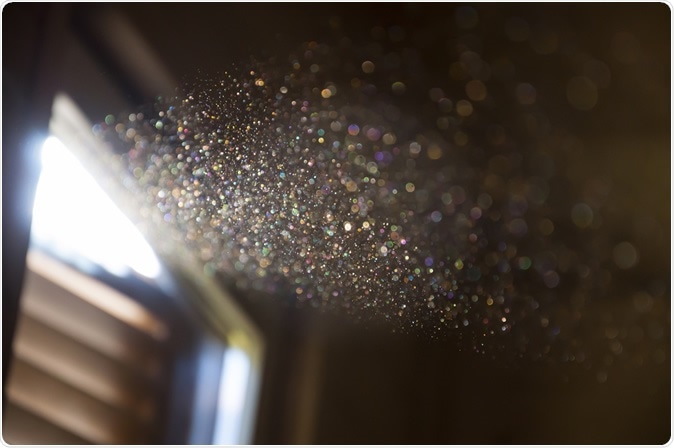Bacteria enter our homes on our the skin, or through the air, but once inside they may transfer antibiotic resistance traits to other bacteria residing in the indoor dust, a possibility raised by a new study.
The study, published in January 2020 in the journal PLOS Pathogens, suggests that these indoor bacteria acquire antibiotic resistance from outdoor bacteria, making previously treatable germs newly untreatable by conventional antibiotics.

Image Credit: Struvictory / Shutterstock
Antibiotics and resistance
Antibiotics work by inhibiting one or more essential metabolic or anabolic pathways in pathogenic bacteria. For instance, some weaken the bacterial cell wall, others prevent the replication of DNA or inhibit the synthesis of key proteins. However, even though antibiotics are potent and have provided miracle cures for formerly lethal diseases like pneumonia and tuberculosis, they also have their weaknesses. One is that bacteria can acquire mutations to work around the mechanism of damage caused by the antibiotic.
Antibiotic-resistant bacteria have long been the target of scientists who searched for them in healthcare facilities. A few studies have detected the presence of genes responsible for antibiotic resistance in indoor dust. The question is whether these genes are viable and can be picked up by other bacteria, making them resistant, in turn. This is an important question to answer because city dwellers are indoors for about 87% of their time, according to data from the 2001 National Human Activity Pattern Survey.
Gene transfer in bacteria
Bacteria share their genes in two ways: by binary fission, where each bacterium divides into two, or by horizontal gene transfer, where the bacterium duplicates its genes and then exchanges one copy with another bacterium. Almost any type of gene can be shifted around provided it has transposable, or mobile, elements. This type of mobile element in the antibiotic resistance genes found in bacteria living in indoor dust was found for the first time by the researchers in the current study.
In short, even with just a relatively low concentration of disease-causing germs indoors, the sheer volume of time spent inside the house leads to a much higher chance of being exposed to them. It is quite plausible that a bacterium that doesn’t cause disease could float in from the outside. If stressed, it could donate its genes to a disease-causing germ living indoors, making the latter both pathogenic and antibiotic resistant. This could cause a disease that is almost impossible to treat except symptomatically.
Proving the hypothesis
Says senior author Erica Hartmann, “We never really know where the next antibiotic-resistant organism is going to come from.” In pursuance of this idea, the researchers collected samples of microbes from over 40 different indoor sites, ranging from fitness clubs to recreation or yoga centers.
The dust gathered from each location was analyzed to identify the different types of microbes that could have passed through it, by studying the genetic material in the dust. This showed that over 180 antibiotic-resistance genes were present in the dust. However, the researchers also probed the possibility that these genes could be transferred between bacteria.
How this occurs is via the structures called integrons, plasmids and transposons. These provide an easy mechanism for DNA bits to travel between microbes. Thus, the scientists looked for such structures in the vicinity of antibiotic-resistant genes. Their search was rewarded by the discovery of over 50 such fragments of DNA.
These were now cultured in the laboratory and the scientists attempted to visualize the actual transfer of these ‘jumping genes’. This was by triggering a gene transfer between the bacteria. However, they failed to catch this in action. That is, even though these structures contain the genes of interest, they weren’t able to achieve a gene transfer.
Conditions suboptimal for gene transfer
However, Hartmann adds, the conditions might not have been optimal for this transfer to happen. Instead, under certain indoor conditions the bacteria floating around might be under stress because of atmospheric dryness, lack of nutrients, too high or too low temperatures, or the presence of antimicrobial chemicals, such as found in cleaning products. Such stress conditions promote gene transfer to nearby microbes which could be better able to survive such conditions. The only problem is that this transfer hasn’t yet been seen directly by any researcher.
Implications
The new study indicates the possibility of such transfers occurring in all kinds of indoor situations. The question now is whether such events truly pose a threat by providing a significant source of antibiotic resistant microbes, or they are just exchanges occurring between nonpathogenic bacteria.
In support of the second option, Hartmann points out, “We are surrounded everywhere we go by microbes, and the vast majority of those microbes are not harmful.” The next step is to do more research into how, where and when antibiotic-resistance genes are transferred to disease-causing bacteria, particularly when the environment is one exposed to common cleaning solutions, to determine if this triggers the transfer of antibiotic resistance.
Summing up, she questions: “If you were going to change something about the way you clean, the products you use, what could we do to limit antibiotic resistance?” For instance, it might well be that using a different type of disinfectant or household cleaner could prevent such gene transfers and the spread of antibiotic resistance.
Journal reference:
Mobilizable antibiotic resistance genes are present in dust microbial communities Ben Maamar S, Glawe AJ, Brown TK, Hellgeth N, Hu J, et al. (2020) Mobilizable antibiotic resistance genes are present in dust microbial communities. PLOS Pathogens 16(1): e1008211. https://doi.org/10.1371/journal.ppat.1008211